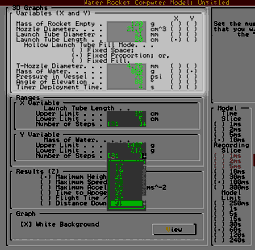|
Graphs are plotted with the x and y axes
selected from the Variables part of the form.
 The variables are either on the Input Parameters
form or relate to it. If you have elected not
to use a particular part of the model - such
as a launch tube - the variables relating to
it will not be available for selection. In
addition, if you do not select a hollow
launch tube, the fill mode (explained below)
will not be available. The variables are either on the Input Parameters
form or relate to it. If you have elected not
to use a particular part of the model - such
as a launch tube - the variables relating to
it will not be available for selection. In
addition, if you do not select a hollow
launch tube, the fill mode (explained below)
will not be available.
The variables that are available are:
 |
Mass
of Rocket Empty - You
will see the optimum mass for
whatever output variable you select -
weights for horizontal distance are
usually heavier than for maximum
height; |
 |
Nozzle
Diameter - With wider
rockets, such as those made from pop
bottles, the optimum diameter is
usually smaller than fully open as
the drag force on the rocket comes
into play and a longer, slower accent
is better; |
 |
Launch
Tube Diameter -
Generally the wider the better
although limited to the diameter of
the nozzle. This is not available if
a launch tube is not selected; |
 |
Launch
Tube Length - The
longer the better up to a point. With
smaller diameter bottles and long,
effectively solid launch tubes, the
launch tube takes up a significant
proportion of the capacity of the
rocket and the pressure can drop too
much so there is a maximum for
narrower rockets. This is not
available if a launch tube is not
selected; |
 |
Hollow
Launch Tube Fill Mode
- With a hollow launch tube, the
optimum length will vary with the
fill. The model can take this into
account by giving you the option of
selecting a type of fill for varying
the length of the launch tube. This
is not available if a hollow launch
tube is not selected: |
| |
 |
Fixed
Space - Fixed space
used for tubes in rockets that are
filled slowly - ie, only have a
certain volume of air in the water; |
 |
Fixed
Proportion -
Proportional spaced tubes used for
tubes in rockets that are pressurised
quickly so that a fixed proportion of
the tube is air with the rest water;
or, |
 |
Fixed
Fill - Fixed fill
tubes used for tubes with a fixed
portion filled by, say, a T-nozzle
support or an adapter - something
that occupies the same volume
regardless of the length of the tube,
or tubes that are always dry - ie,
compressed air only. |
 |
T-nozzle
Diameter - This is
the diameter of the hole in the
t-nozzle. Needless to say that it
cannot exceed the diameter of the
bottle's nozzle. This is not
available if a launch tube and a
t-nozzle are both not selected; |
 |
Mass
of Water - There are
optimum values for different types of
flight - maximum height, downrange
distance and so on, depending upon
the pressure and the weight of the
empty rocket; |
 |
Pressure
in Vessel - Higher
pressure means better performance but
this variable is included so that the
graphical output of the model can be
used to select optimum values for
other parameters such as weight of
rocket, mass of water and so on, for
use in the field; |
 |
Angle
of Elevation - find
an optimum launch angle for the
downrange distance. This can give
surprising results for t-nozzles when
the weight becomes close to critical;
and, |
 |
Timer
Deployment Time -
find the optimum time for deployment
of the recovery method. This should
be a little before apogee dependent
upon the distance the rocket needs to
travel to deploy the chute fully. |
Copyright
©2000 Paul Grosse. All Rights Reserved
|